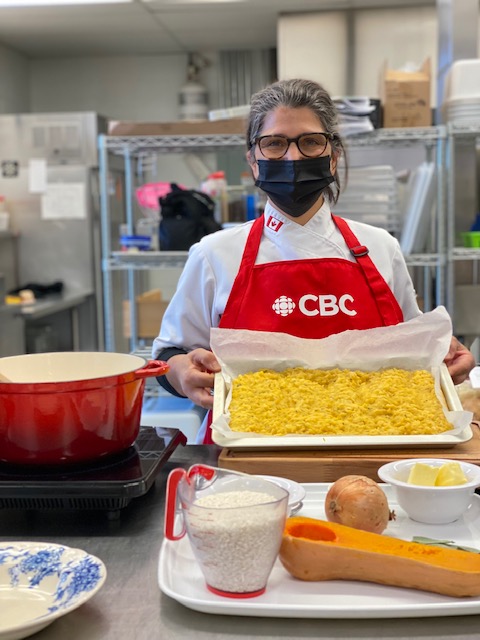 For many years leading to the decision to transition into a PTA-run cafeteria, families and school staff were dissatisfied with the food served in the cafeteria. Discussions in the PTA and Student Advisory Council (SAC) expressed deep concern about the menu selections that offered highly processed meals with limited nutrition and a lack of fresh vegetables and fruit. Intending to work together to make changes to the food served, families and school administrators made multiple attempts to engage with the food service provider to voice their concerns. They experienced many roadblocks in their attempts to suggest healthier lunch options, resulting in minimal changes to the menu. The lunch program had meagre sales and a lack of interest or enthusiasm from the general school community. Both the school and the wider parent community were interested in providing nutritious options for students at an affordable price and identified a need for change. There were examples of other schools in the area that had previously switched to a PTA-run cafeteria, and KCA was keen to make the transition.
For many years leading to the decision to transition into a PTA-run cafeteria, families and school staff were dissatisfied with the food served in the cafeteria. Discussions in the PTA and Student Advisory Council (SAC) expressed deep concern about the menu selections that offered highly processed meals with limited nutrition and a lack of fresh vegetables and fruit. Intending to work together to make changes to the food served, families and school administrators made multiple attempts to engage with the food service provider to voice their concerns. They experienced many roadblocks in their attempts to suggest healthier lunch options, resulting in minimal changes to the menu. The lunch program had meagre sales and a lack of interest or enthusiasm from the general school community. Both the school and the wider parent community were interested in providing nutritious options for students at an affordable price and identified a need for change. There were examples of other schools in the area that had previously switched to a PTA-run cafeteria, and KCA was keen to make the transition.
From the school administration’s point of view, the first step of the transition was the most challenging. It was a two-year process to end the existing food service provider contract, involving multiple meetings with the Regional Centre for Education and the service provider. This process required the school to allow the current contract to end and to demonstrate that the provider was not meeting the school’s standards for healthy food.
When the school was in a position to move forward with the plan to end the food service contract, the principal came to the PTA in May 2019 with the bold idea to transition to a PTA-run cafeteria for the fall of 2019. With an expression of interest from a Red Seal Chef interested in joining the program, the principal approached parent volunteers who had a keen interest in healthy school food and a desire to contribute to the health-promoting school culture. With nervous/excited enthusiasm, the Cafeteria Committee formed immediately! Two volunteers worked throughout the summer of 2019 to figure out the logistics of developing and managing a PTA-run healthy lunch program. The initial planning included, but was not limited to:
- Hiring the head chef
- Discussing menu items
- Creating a staff contract
- Opening a bank account
- Securing a Food Establishment Permit
- Purchasing kitchen equipment
- Opening accounts with various suppliers
These initial plans were made possible by a generous $5000 start-up budget from the PTA to cover the cost of food, equipment and wages for the first couple of months. It was a steep learning curve for the volunteers and truly a labour of love.
When the program opened that first fall, volunteers photocopied 600 menus weekly for students to take home and return with their order form and payment, which were cash and cheques only. The information was manually inputted into a spreadsheet of student names and classes, and the money was counted, rolled and deposited at the bank. One paid staff person worked in the kitchen, and a rotating list of daily volunteers helped with the lunch service and clean-up. For the first year of operation in 2019/20, the daily lunch item was $3.50/meal or $3.90/meal, including milk.
The head chef created a lunch menu that followed the nutritional guidelines provided by the Food and Nutrition Policy for NS Public Schools, using existing local resources and recipes and Nourish NS’ Local Food Lunch Toolkit for food service providers. The rotating lunch menu includes lasagna, burritos, soups, spaghetti, noodle salads, casseroles, tacos, chili, sandwiches, butter chicken, wraps, etc. All meals have a main serving or a side of vegetables/fruit.
Despite the upheaval and uncertainty of Covid-19, it was a blessing in disguise for the lunch program. Due to changing restrictions and regulations, the PTA Cafeteria Committee had to quickly adapt the program to meet the needs of the changing school environment. All menus and order forms moved to an online format in Google Forms, and most payments were received by e-transfer to the PTA Cafeteria bank account. Thankfully, this was a reasonably smooth transition as families were already getting used to working online. The new online process significantly reduced the time needed for volunteers to process payments. For the second and third years of operation, the daily lunch item was priced at $4.00/meal due to rising food costs and the additional costs of purchasing compostable boxes for classroom delivery (due to Covid-19 regulations for students to eat in classrooms vs open cafeterias).
![]()
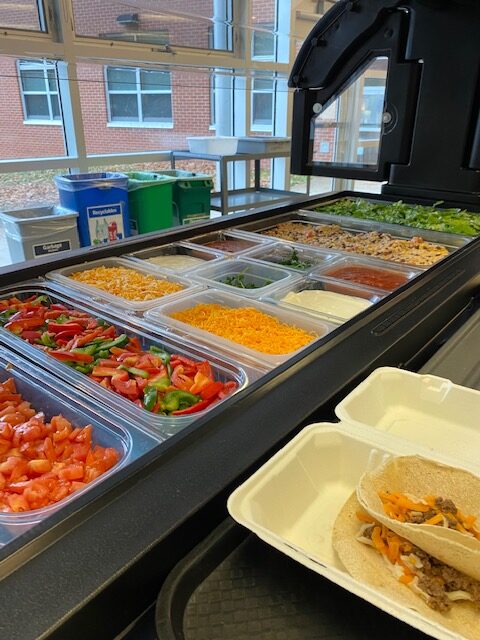 Kings County Academy (KCA) is a pre-primary to grade 8 school located in Kentville, Nova Scotia, with an early French Immersion stream. KCA has a strong partnership with the municipal Parks and Recreation Department and a long history of a vibrant and dedicated Parent Teacher Association (PTA). The school has an enrollment of 630 students and 70 staff members, and KCA is in an agriculturally rich community. However, the community has a child poverty rate of 23.4%, with many families having inadequate access to healthy, affordable food.
Kings County Academy (KCA) is a pre-primary to grade 8 school located in Kentville, Nova Scotia, with an early French Immersion stream. KCA has a strong partnership with the municipal Parks and Recreation Department and a long history of a vibrant and dedicated Parent Teacher Association (PTA). The school has an enrollment of 630 students and 70 staff members, and KCA is in an agriculturally rich community. However, the community has a child poverty rate of 23.4%, with many families having inadequate access to healthy, affordable food.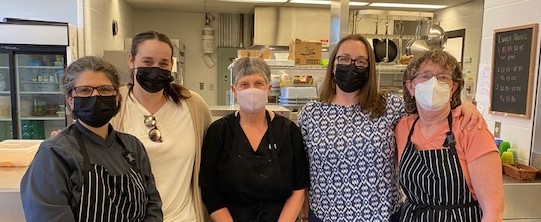


 For many years leading to the decision to transition into a PTA-run cafeteria, families and school staff were dissatisfied with the food served in the cafeteria. Discussions in the PTA and Student Advisory Council (SAC) expressed deep concern about the menu selections that offered highly processed meals with limited nutrition and a lack of fresh vegetables and fruit. Intending to work together to make changes to the food served, families and school administrators made multiple attempts to engage with the food service provider to voice their concerns. They experienced many roadblocks in their attempts to suggest healthier lunch options, resulting in minimal changes to the menu. The lunch program had meagre sales and a lack of interest or enthusiasm from the general school community. Both the school and the wider parent community were interested in providing nutritious options for students at an affordable price and identified a need for change. There were examples of other schools in the area that had previously switched to a PTA-run cafeteria, and KCA was keen to make the transition.
For many years leading to the decision to transition into a PTA-run cafeteria, families and school staff were dissatisfied with the food served in the cafeteria. Discussions in the PTA and Student Advisory Council (SAC) expressed deep concern about the menu selections that offered highly processed meals with limited nutrition and a lack of fresh vegetables and fruit. Intending to work together to make changes to the food served, families and school administrators made multiple attempts to engage with the food service provider to voice their concerns. They experienced many roadblocks in their attempts to suggest healthier lunch options, resulting in minimal changes to the menu. The lunch program had meagre sales and a lack of interest or enthusiasm from the general school community. Both the school and the wider parent community were interested in providing nutritious options for students at an affordable price and identified a need for change. There were examples of other schools in the area that had previously switched to a PTA-run cafeteria, and KCA was keen to make the transition. 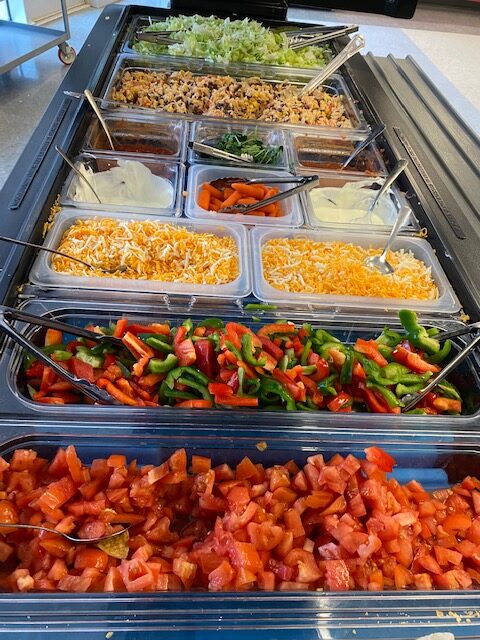 One of the most apparent successes that we’ve seen is that the number of students participating in the lunch program has increased dramatically. The new PTA-run cafeteria went from serving 128 meals/week during the first week of operation in September 2019 to 1200 meals/week in April 2022. The lunch program currently serves an average of 200-300 meals/day, with a rotating and varied menu selection. Students are trying new foods, and exploring new types of cuisine, and the feedback from families is overwhelmingly positive. Dietary modifications are also available with this program – vegetarian, gluten-free, dairy-free and lactose-free options are available for each lunch item. A salad bar unit was purchased at the end of 2019 with funding support from the Annapolis Valley Regional Centre for Education (AVRCE). The weekly salad bar option was added to the program to expand further the availability of vegetables and fruits and student involvement in the program. Unfortunately, due to Covid-19 restrictions, there were periods throughout the past two years when the salad bar was not in service.
One of the most apparent successes that we’ve seen is that the number of students participating in the lunch program has increased dramatically. The new PTA-run cafeteria went from serving 128 meals/week during the first week of operation in September 2019 to 1200 meals/week in April 2022. The lunch program currently serves an average of 200-300 meals/day, with a rotating and varied menu selection. Students are trying new foods, and exploring new types of cuisine, and the feedback from families is overwhelmingly positive. Dietary modifications are also available with this program – vegetarian, gluten-free, dairy-free and lactose-free options are available for each lunch item. A salad bar unit was purchased at the end of 2019 with funding support from the Annapolis Valley Regional Centre for Education (AVRCE). The weekly salad bar option was added to the program to expand further the availability of vegetables and fruits and student involvement in the program. Unfortunately, due to Covid-19 restrictions, there were periods throughout the past two years when the salad bar was not in service. 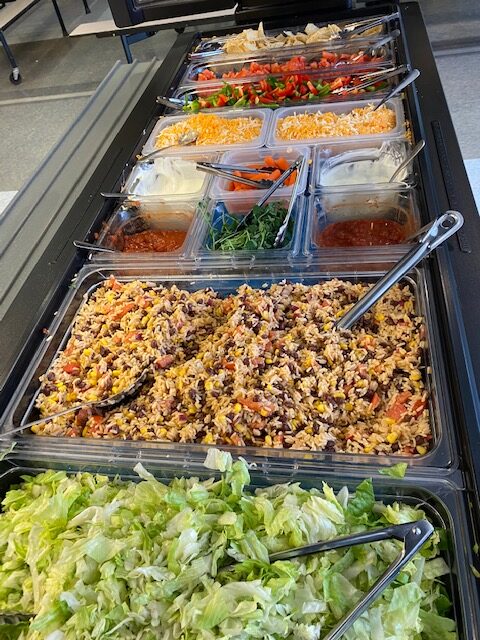 Mistakes and missteps happen. The Cafeteria Committee and the kitchen staff work with our families, students and school to gain feedback on what is working and not working and then adjust. The Cafeteria Committee hosts regular check-in meetings with cafeteria staff to ensure everyone is on the same page and to brainstorm ways to improve the program and lunch service. With an engaged parent community eager to ask questions, provide feedback, and raise concerns, the Committee can address and find timely solutions to issues as they arise.
Mistakes and missteps happen. The Cafeteria Committee and the kitchen staff work with our families, students and school to gain feedback on what is working and not working and then adjust. The Cafeteria Committee hosts regular check-in meetings with cafeteria staff to ensure everyone is on the same page and to brainstorm ways to improve the program and lunch service. With an engaged parent community eager to ask questions, provide feedback, and raise concerns, the Committee can address and find timely solutions to issues as they arise. 

